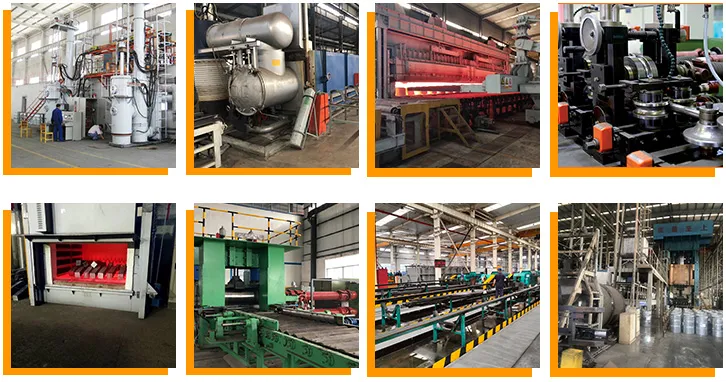
Titanium Welded Tubes are manufactured by cold-rolling or strip-forming titanium coils and longitudinally welding them with or without filler metal. These tubes provide an excellent combination of strength, corrosion resistance, and cost efficiency, making them ideal for non-structural applications, especially where smooth inner surfaces and consistent wall thickness are required.
Compliant with ASTM B338 / B862, titanium welded tubes are widely used in heat exchangers, condensers, seawater desalination systems, and chemical processing equipment.
|
OD |
Wall Thickness |
Length |
Applications |
|
12.7 mm (1/2") |
0.5 – 2.0 mm |
3000-6000mm |
Titanium welded tubes for condenser and heat exchanger |
|
19.05 mm (3/4") |
0.5 – 2.5 mm |
3000-6000 mm |
Titanium welded tubes for process lines and small structural uses |
|
25.4 mm (1") |
0.8 – 3.0 mm |
3000-8000 mm |
Titanium welded tubes for chemical piping and tubing assemblies |
|
38.1 mm (1.5") |
1.0 – 3.5 mm |
3000-8000 mm |
Titanium welded tubes for seawater systems and gas lines |
|
50.8 mm (2") |
1.0 – 4.0 mm |
3000-8000 mm |
Titanium welded tubes for industrial fluid transmission |
|
63.5 mm (2.5") |
1.5 – 4.5 mm |
4000-10000 mm |
Titanium welded tubes for exhaust systems and marine piping |
|
76.2 mm (3") |
1.5 – 5.0 mm |
4000-10000 mm |
Titanium welded tubes for offshore piping and condensate drains |
|
101.6 mm (4") |
2.0 – 6.0 mm |
4000-12000 mm |
Titanium welded tubes for structural supports and chemical lines |
|
114.3 mm (4.5") |
2.0 – 6.0 mm |
4000-12000 mm |
Titanium welded tubes for low-pressure pipelines, vessels |
Titanium
Strip Preparation
Titanium coils or plates are slit into precise strip widths and cleaned to
remove surface oxide and contamination.
Forming
The strip is continuously roll-formed into a tubular shape using precision
rollers.
Welding
The edges of the tube are welded longitudinally usingTIG (Tungsten
Inert Gas)orLaser weldingunder an inert atmosphere
(usually Argon) to ensure a clean, high-quality weld.
Weld
Bead Treatment
Internal and external weld beads may be ground or leveled as required to ensure
smooth surface and accurate dimensions.
Heat
Treatment (Optional)
Annealing may be performed in a vacuum or inert atmosphere furnace to relieve
stress and improve ductility.
Sizing
& Straightening
The welded tube is passed through a sizing mill to achieve precise diameter and
roundness, followed by straightening.
Surface
Finishing
Tubes are pickled, polished, or bright finished depending on application
requirements.
Non-Destructive
Testing (NDT)
Includes eddy current testing, hydrostatic testing, and/or ultrasonic testing
to ensure tube integrity and quality.
Cutting
& Inspection
Tubes are cut to specified lengths, deburred, visually inspected, and checked
for dimensional accuracy.
Packaging
Final tubes are packed in protective wrapping or wooden cases to avoid
mechanical damage and contamination

|
GRADE |
N |
C |
H |
Fe |
O |
Mo |
Ni |
Al |
V |
Residual |
Residual |
Ti |
|
Gr1 |
0.03 |
0.08 |
0.015 |
0.20 |
0.18 |
--- |
--- |
--- |
--- |
0.1 |
0.4 |
BAL |
|
Gr2 |
0.03 |
0.08 |
0.015 |
0.30 |
0.25 |
--- |
--- |
--- |
--- |
0.1 |
0.4 |
BAL |
|
Gr5 |
0.05 |
0.08 |
0.015 |
0.40 |
0.2 |
--- |
--- |
5.5-6.75 |
3.5-4.5 |
0.1 |
0.4 |
BAL |
|
Gr12 |
0.03 |
0.08 |
0.015 |
0.30 |
0.25 |
0.2-0.4 |
0.6-0.9 |
--- |
--- |
0.1 |
0.4 |
BAL |
|
GRADE |
TENSILE STRENGTH |
YIELD STRENGTH |
ELONGATION |
|
Gr1 |
≧240 |
138 - 310 |
≧24 |
|
Gr2 |
≧345 |
275 - 410 |
≧20 |
|
Gr5 |
≧895 |
≧828 |
≧10 |
|
Gr12 |
≧483 |
≧345 |
≧18 |
Heat Exchangers & Condensers – smooth flow and corrosion resistance
Seawater Desalination Plants – brine-resistant tubing
Chemical Processing Equipment – acid-resistant tube lines
Power Plant Cooling Systems – condenser tubing
Pharmaceutical & Food Processing – clean process lines
Pulp & Paper Industry – bleaching system piping
Titanium Exhaust or Transfer Lines – low-pressure applications
Titanium welded tubes are packed for safe transport and corrosion protection, especially for export and sensitive installations:
Inner Packaging:
Ends protected with plastic caps
Tubes individually wrapped in plastic film, PE bags, or anti-rust paper
Outer Packaging:
Bundled with nylon straps and packed in plywood cases or wooden crates
Foam or cardboard spacers used to avoid surface scratches
Marked with grade, OD × WT, length, heat number, and batch number